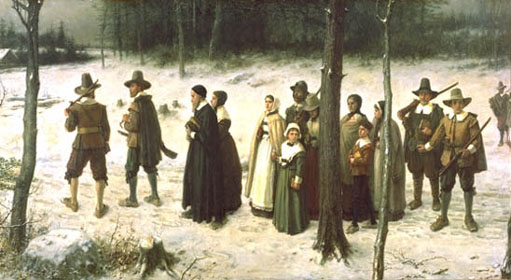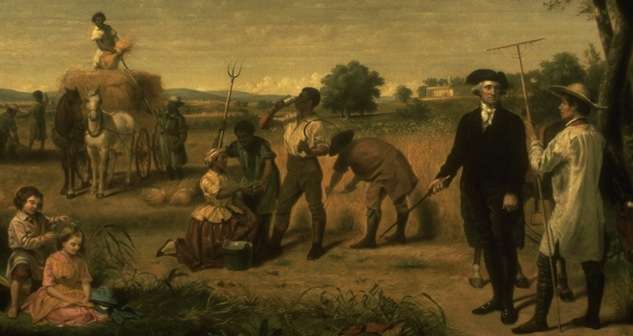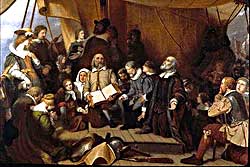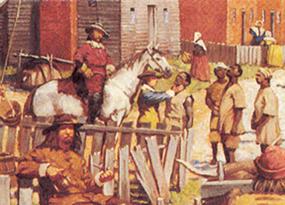
From the Opinion Pages of the Boston Globe, "New England’s scarlet ‘S’ for slavery," by C. S. Manegold, a former reporter with The New York Times, Newsweek, and the Philadelphia Inquirer, is the author of “Ten Hills Farm: The Forgotten History of Slavery in the North.’, published on 18 January 2010.
ALMOST HALF a century ago, Martin Luther King Jr. captured a problem that still plagues us today. Cautioning his flock against the complacent embrace of incomplete knowledge, he warned: “Nothing in all the world is more dangerous than sincere ignorance and conscientious stupidity.’’
I have thought of those words often in the last few years as I worked to unearth the history of a century and a half of slavery on a Massachusetts farm first owned by the famous Puritan, Governor John Winthrop, whose “Model of Christian Charity’’ is often quoted even now.
 |
| John Winthrop (1587-1649), The First Governor of Massachusetts |
In the several times I have presented these unpleasant truths in talks at major universities, I have inquired afterwards - who knew this history of slavery in the North? Usually only about three hands go up of 30. And most of these people are professors. Among non-professors the void is even deeper. Students, stumbling on this news, tend to ask with some aggression: “Why didn’t they teach us this?’’ Why didn’t I know?
I am older, and I grew up in a different time, but I said these words myself not long ago. Now that I know better, I realize there are many answers to the question. But the best perhaps are these: Easier not to. More comfortable not to.
Yet as King suggested, responsible dialogue can not move forward with half-truths and willful ignorance. In this regard, the North has work to do. It lags behind the South in stepping up to ugly truths.

Let me share a simple primer: The first men, women and children to be enslaved by whites in New England were Native American prisoners of war doled out as favors to other tribes who had allied themselves with the settlers’ cause, or to white soldiers who fought with some distinction in those wars. “There is a little Squa that Steward Calacot desireth,’’ wrote one hopeful recipient to Winthrop. “Lieutenant Damport also desireth one, to witt, a tall one with three strokes upon her stomach. . ..’’
Among these enslaved Indians, some were shipped off to the Caribbean where they were traded for “cotton, and tobacco and Negroes,’’ as Winthrop noted in his famous journal. The year was 1638. On October 3, 1639, the Massachusetts Court of Assistants ruled “the Governor had leave to keep a Narragansett Indian and his wife.’’ Other Northern settlers had already chosen blacks; and those first African slaves to reach New England were followed by a constant and accelerating flow. The pattern would repeat until black slavery in the North became a common fact of life transcending social class.
Nor was this slavery somehow “soft.’’ One of the first published accounts of life in New England tells of a man who lived near what today is Logan Airport. That man, Samuel Maverick, ordered one slave to rape another, that he might have a “breed of Negroes.’’ Other tragic stories abound. Many more are lost forever.

Slavery, though, was legal. Winthrop, the author of the notion of America as a “city upon a hill,’’ helped to make it so. Three years after the first shipment of enslaved Africans arrived on Massachusetts soil, he helped to write the first law in North America officially sanctioning the practice. The Massachusetts Body of Liberties in 1641 decreed there “shall never be any bond slavery’’ (good enough so far. . .) “unless it be lawful captives taken in just wars, and such strangers as willingly sell themselves or are sold to us.’’ [italics added]
Who could this formulation possibly leave out?
Follow the money. Find the families. Together they will tell the story. In the case of slavery in the North, they tell a story of enslavement stretching in a single weave from Massachusetts, Rhode Island, Connecticut. . . to Barbados, Antigua, Surinam. . . to Africa. Today there is a Winthorp (sic) Bay in Antigua near the international airport. It is named for Winthrop’s son Samuel, who served as lieutenant governor and presided over a large plantation worked by slaves. Samuel’s brother, John Jr., the governor of Connecticut, owned black slaves on many properties, as did his siblings, heirs, and friends. On and on it went.
On the same land Governor Winthrop first had farmed, other families would come. They were slave-owners, too, every one. Slavery did not end in Massachusetts until after the American Revolution when a series of “freedom suits’’ taken to the courts by slaves and free blacks impelled the legislators to live up to their grand rhetoric of freedom.

The end was neither swift nor definitive. Not a single newspaper article from the time made note of the end of a century and a half of bondage. Instead, the high court finally ruled, and then there were debates over semantics until, farm by farm, owner by owner, the practice sputtered, and then failed. But not before some of those enslaved had been sold back to the Caribbean so an owner could avoid a difficult financial loss.
Only Vermont explicitly outlawed slavery in its constitution in 1793. Article One: “Slavery prohibited.’’ That was the exception, not the rule.
Then we forgot.
But the forgetting took time. Remnants of the truth remained in 1915 when, on what was left of Winthrop’s “Ten Hills Farm,’’ a three-day pageant celebrated America’s early history. Among the players were John Winthrop, George Washington, the slave Belinda, and a slave named George who killed himself rather than be sold. Newspapers crowed about the refreshing inclusivity of the event. But those accounts referred only to impoverished Irish and Italian immigrants who had followed the trolley tracks to move outside of Boston. George and Belinda were white folk dressed in blackface. The larger slave population (which counted at least 27 on that farm in the 1700s) sat huddled on a bench. Photographs still show them there - white boys from the Medford High School Glee Club, their faces rubbed with coal.

Perhaps in 1915 the memory was still too fresh to fade. Twenty-three years later, the same was true. That year, the WPA artist Henry Billings dipped his brush to paint an enormous mural for the Medford Post Office. His “Golden Triangle of Trade’’ shows a white sailor leaning up against a post. That man is watching another, a black man, working, cane upon his shoulder, manacles lying open in the tropical sand. The triangle above them - topped by a huge American eagle - sweeps from Africa, across the Caribbean, and then straight to Boston Harbor. That history was still perhaps too fresh to kill.
The North has surely done a good job since.
Think of the South, and slavery immediately comes to mind. Think of the North, and there march in the heroes and the Patriots, the stern-faced abolitionists, poets and philosophers. In time, the vanishing was almost total. Visitors who go to 105 Brattle Street in Cambridge today usually go there to visit Henry Wadsworth Longfellow’s old house without realizing the slave past (Cuba, Tony, Darby. . .) that stretched way back inside those walls.
Did Barack Obama know, when he studied law at Harvard, that the basement apartment he rented in Somerville lay on ground that hosted slavery for 150 years? Did his dean welcome students with the information that the Law School was created out of money made partly from the work of and trade in men who never saw a day of freedom?

This void in general knowledge persists five years after the powerful exhibit in 2005 by the New York Historical Society, “Slavery in New York.’’ It persists as scholars strain and labor to uncover deeper aspects of this past. It persists though this is 150 years lost, not 10. And it persists despite the fact that statistics from the period of the American Revolution tell an abbreviated story of at least 10,000 souls enslaved across the North, not a handful of domestic “servants’’ afforded gentle treatment.
“We have memorized America,’’ the poet Miller Williams wrote.
He was eloquent. But he was wrong.
The national dialogue has stalled on easy binaries: North/South. Abolitionists/slave owners. Blue states/red states. You know the drill. Miller Williams asks us to look forward to be true to values we have always held. It’s a lovely thought. But honestly, it would be better to heed King’s warning, and look backward at a past imperfectly remembered.
Then, just maybe, we can talk. (source: The Boston Globe)

It would seem that most are aware of, at least in a cursory sense, that slavery existed during the time of the founding, though it is usually a bit of a shock to divulge the details which are often ignored - even forgotten, as you point out. But we must remember that the north, in contrast to the institutionalizing and ingraining of slavery into the fabric of southern culture, gradually weeded out overt slavery from society and set the stage, through much abolitionist agitation, for the eventual eradication of slavery throughout the United States.
ReplyDeleteFrom its web based parking reservation system, Park 'N Fly provides web-based access to a network of airport parking spots covering 50+ airports.
ReplyDeleteThis comment has been removed by the author.
ReplyDeletethis is really amazing post thanks for share it, this time to must know about it CAN DOGS EAT SHRIMP visit for more interesting articles
ReplyDeleteToto Site Power and racial recognition is a process to assess the capital capacity of a private Toto company as well as to determine whether the prize money can be successful. Toto's magnificent playground and playground are the highest point Toto has gone through food and exploration. 토토사이트 this website 안전놀이터
ReplyDeleteYou additionally know wordle is turning into standard all around the world, everyone performs wordle, everyone talks wordle. Wordle seems on each media and social community. Wordle's appeal is difficult to think about.
ReplyDeleteHowever what if you cannot resolve the wordle at the moment? Did you make full use of 6 guesses? The desk has no clue to decipher the important thing. Or just you wish to problem wordle repeatedly with out stopping. This wordle website was born so that you can play wordle in a totally totally different approach.
You should also love fnaf 3 one of the hottest games today.
ReplyDeleteGreat job for publishing such a beneficial web site
Your Blog is awesome. Really appreciate your work!
ReplyDeleteThank you for always writing good things.
ReplyDelete
ReplyDeleteGreat blog site. Keep up the good work!
It was a great show , really enjoyed it
ReplyDeleteKeep up the good writing. please visit our beautiful website, spread the love, thankyou
ReplyDeleteTHANKS FOR GIVING EVERYONE A REMARKABLY MEMORABLE
ReplyDeletepalm angels
ReplyDeletejordan outlet
jordan travis scott
golden goose
supreme clothing
Experience the excitement of ipl win casino, where thrilling games and big wins await cricket fans and gaming enthusiasts alike.
ReplyDeleteExplore the excitement of online betting with 24kbet app, your premier destination for thrilling gaming experiences and big wins.
Access your fantasy cricket league and stay updated with live scores by logging in to ipl win login, the ultimate platform for cricket enthusiasts.